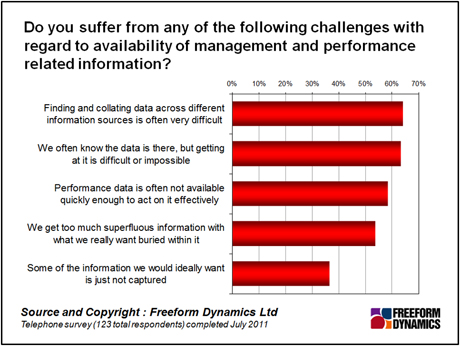The pace at which modern business tends to move has resulted in a situation where centralised decision-making struggles to keep up. In order to get the required level of flexibility and responsiveness, many companies have moved to a devolved organisational structure with local decision-making capabilities.
While this has generally been good from a business point of view, allowing the company to grow or diversify the business, it has also created challenges throughout the organisation. In order to effectively manage such a distributed organisation, the executive team requires comprehensive, accurate and timely information about the performance of the whole business in order to ensure things are steered in the right direction.
The challenge that many companies face though is that investment in IT systems has been fragmented, resulting in a myriad of different, isolated applications. This has lead to a proliferation of independent data stores from which it is difficult to obtain data with which to make meaningful business decisions, with a consequent increase in business risks and costs.
It’s not just a case of information not being captured for later use, although this in itself remains a significant problem, as we can see in Figure 1.

The real problems lie in accessing and analysing the data that has been captured. A big issue is that often data exists, but is inaccessible through practical means, with the result that it may as well not exist for the amount of time, effort and expense spent on capturing and storing it.
There is an inverse problem here too, in that where wanted data exists and is very accessible, a mountain of superfluous data may also be provided in response to a query or request. Ironically, it is in companies where IT is considered to be well-aligned to the business that this problem is felt most acutely do to the amounts of data that automated transactions or processes tend to generate.
The information delivery problem is further exacerbated by problems of performance and integration. Often critical information takes too long to get to decision makers, rendering it useless for operational planning.
And this difficulty in delivering information quickly is tied to probably the biggest information issue suffered by many companies, that of disparate data stored in different systems. This makes pulling all the data sources together and collating the information tricky to perform. Because of this the business incurs a lot of additional overhead as staff manually pull the data together, while decision makers get incomplete information, or information that arrives too late to be useful.
This information gap is clearly a major issue for many companies. Getting to grips with it requires senior business managers to rethink how and why they use information and IT services. Technology can help to solve the problem, but without direction will usually result in a piecemeal approach that will only serve to exacerbate the problem in the longer term.
Really getting to grips with the challenge requires a change in mindset of senior management with regards to information management and ownership, because this is a business problem rather than an IT problem. At the top of the list of challenges, when it comes to business optimization and change, is the lack of clear ownership of business information.
A good starting point to solving this problem is to form a team whose job– with the backing of the senior management – is to oversee business information within the company. This team would build an understanding of the information needs, and its mandate should be to ensure that information is consistent and accessible, as well as used effectively.
The general approach is to put in place structure and process that are able to bridge departmental and/or IT systems boundaries to enable a move towards increasingly coherent and integrated information sources as time progresses. This will ensure that while short term needs are still met, over the longer term the information architecture is fleshed out and delivers increased value to the business.
The key to success in all this is getting senior management buy-in, otherwise the increased effort and costs associated with developing and building the information framework will eat away at the will (and budgets) of those involved. In situations like this, reverting to the old ways will be very tempting. To get the buy-in, it’s important to set expectations at a realistic level. By all means set out the stall for the long term vision, but make sure that the path forwards is smooth, steady and above all attainable.
CLICK HERE TO VIEW ORIGINAL PUBLISHED ON

Content Contributors: Andrew Buss